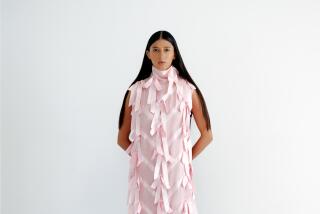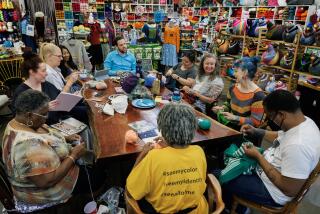DESIGN : Some Needling and a New Respect
- Share via
GLENDALE — We take for granted the multicolored baskets that hang from the kitchen ceiling, hold mismatched pens and prop up our plants. I certainly ignored the baskets that dot my coffee tables and shelves.
Until now.
Curious to try something everyone joked about in school but never actually experienced, I registered for a basket-weaving class at Glendale Community College. Friends and relatives teased me about taking up such a seemingly facile hobby, asking: “Is it underwater basket weaving?”
Although it wasn’t an underwater weaving class, I told them, it featured pine needles as the material of choice--something that made the session more intriguing.
The class was a first for me in many ways. Not only have I never enrolled in any kind of crafts seminar, I also lack the patience to finish crafts once I start them.
The basket-weaving session marked a crossroads. Or should I say a cross-stitch? Our instructor, Lois Rainwater, a former elementary teacher, has made baskets her life for the past 15 years.
She can weave just about anything together--day lily, willow, iris, wisteria, palm, and kelp--into beautiful, functional baskets.
This is impressive, believe me.
After a six-hour basket-weaving marathon, I feel compelled to dispel the myth that hovers over the craft like bad breath. It is not easy. Anyone who jokes about basket weaving has no inkling of how difficult this ancient art is.
Baskets predate pottery, Rainwater told us. Native Americans have used them for centuries for all sorts of purposes. Women in the South during the Civil War made hats out of pine needles.
These souls also had much more time--and patience--than me. Sitting through hours of basket weaving takes stamina. It also, I found, gives the weaver time to slow down and reflect on life.
A pine-needle basket begins by removing the end portion--or sheath--from each group of needles in a pile of about 80 groups. Raffia, a grass-like material coiled tightly together into strings somewhat like thread, is needed, along with a long metal needle for stitching together the pine needles and raffia.
First, Rainwater--who is not Native American but borrowed her last name from her former second husband--had us hold three groups of needles in one hand. Next, we threaded the raffia into the metal needle, bent the pine needles in the middle, and started sewing around the bent portion to make a coil.
We kept sewing until the entire bend was encircled in raffia. Then we started adding needles into the end of the raffia circle and sewing and bending until we had stitched about seven coils on each side.
This was the bottom of the basket--sort of like a coaster, some of my classmates joked. The circular base for our baskets--mine was around four inches in diameter--took about three hours.
To make sides, we pushed up the pine needles sticking out the end of the base and started stitching through this new layer. This was tough because we had to add a needle every three stitches to keep the basket moving upward.
As we struggled to make the baskets go up, and not out, a classmate, Ada Torres, told of an earlier attempt at basket weaving--using rosemary roots she collected from her driveway after her home burned down in the Glendale fires of 1990.
She piled the roots into a plastic bucket and rinsed them off. Months later, enthralled by their various shapes, she began weaving them into a makeshift basket.
Unable to get the form to stay together, she sought something to hold the roots in place. Torres found colorful pieces of telephone wire at a construction site and wove them into the basket.
Now, she said, she wanted to learn the proper way to weave baskets. Her creativity motivated us to build baskets reflective of our individual talents.
Five hours later, we marveled at how different the same materials looked when left to the creative urges of 10 different pairs of hands. Most of us had completed tiny, uneven oval baskets that stood about two inches high.
My hands were cramped and sore and my back ached as Rainwater told us how Native Americans would spend weeks weaving a single basket.
Having satisfied my curiosity about basket weaving in one afternoon, I’m glad machines weave the ones I collect at home.
WHERE AND WHEN
What: Basket-weaving class. Location: Glendale Community College, Adult Community Training Center, 1122 E. Garfield Ave., Room 10. Hours: 9:30 a.m. to 3:30 p.m. July 8. Price: $39 plus $12 for materials. Call: (818) 548-0864.






